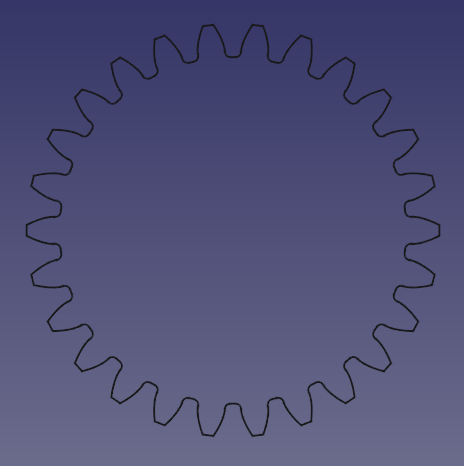PartDesign InvoluteGear/de: Difference between revisions
(Created page with "# Das Zahnradprofil in der Baumansicht Auswählen. # Die Schaltfläche {{Button|16px PartDesign_Pad/de|PartDesign Aufpolsterung...") |
(Created page with "===Ein schrägverzahntes Stirnrad erstellen===") |
||
| Line 42: | Line 42: | ||
# {{Button|OK}} klicken. |
# {{Button|OK}} klicken. |
||
===Ein schrägverzahntes Stirnrad erstellen=== |
|||
=== Create a helical gear === |
|||
{{Version|0.19}} |
{{Version|0.19}} |
||
Revision as of 11:54, 15 November 2022
|
|
| Menüeintrag |
|---|
| Part Design → Evolventenzahnrad... |
| Arbeitsbereich |
| PartDesign |
| Standardtastenkürzel |
| Keiner |
| Eingeführt in Version |
| - |
| Siehe auch |
| Keiner |
Beschreibung
Dieses Werkzeug erlaubt es ein 2D-Profil eines Evolventenzahnrades zu erstellen. Dieses 2D-Profil ist vollständig parametrisch und kann mit den Formelementen PartDesign Aufpolsterung oder PartDesign Wendel extrudiert werden.
Für detailliertere Informationen siehe Wikipedia: Gear und Involute Gear (engl.).
Anwendung
Profil erstellen
- Wahlweise den richtigen Körper aktivieren.
- Zum Menü Part Design →
Involute gear... wechseln.
- Die Evolventenparameter anpassen.
- OK klicken.
- Wurde noch kein Körper aktiviert: Das Zahnrad auf einen Körper ziehen und ablegen, um es mit weiteren Formelementen zu verwenden.
Ein geradverzahntes Stirnrad erstellen
- Das Zahnradprofil in der Baumansicht Auswählen.
- Die Schaltfläche
PartDesign Aufpolsterung drücken.
- Die Daten-EigenschaftLength des Blocks auf die gewünschte Zahnradbreite einstellen.
- OK klicken.
Ein schrägverzahntes Stirnrad erstellen
- Select the gear profile in the Tree view.
- Press the
PartDesign AdditiveHelix button.
- Choose as Axis the normal of the gear profile, that is Normal sketch axis introduced in version 0.20. (In earlier versions the Base Z axis can be used as long as the profile's plane has not been altered.)
- Choose a Height-Turns mode.
- Set the DatenHeight to the desired face width of the gear.
- To set the desired helical angle an Expression for the DatenTurns is required.
- Click the blue
icon at the right of the input field.
- Enter the following formula:
Height * tan(25°) / (InvoluteGear.NumberOfTeeth * InvoluteGear.Modules * pi), where25°is an example for the desired helical angle (also known as beta-value) andInvoluteGearis the DatenName of the profile. - Click OK to close the formula editor.
- Click the blue
- Click OK to close the task panel.
Hint: To make the helical angle an accessible parameter, use a dynamic property:
- Select the profile.
- In the Property editor activate the Show all option in the context menu.
- Again in the context menu, select Add Property. Note: this entry is only available when Show all is active.
- In the Add Property dialog:
- Choose
App::PropertyAngleas Type. - Set
Gearas Group. - Set
HelicalAngleas Name (without a space). - Click OK
- Choose
- Now a new property DatenHelical Angle (space added automatically), with an initial value of
0.0°, becomes available. - Assign the desired helical angle to the new property.
- In the formula of the DatenTurns property of the AdditiveHelix, you can now reference
InvoluteGear.HelicalAngleinstead of the hard coded value of e.g.25°; again assumingInvoluteGearis the DatenName of the profile.
Properties
- Außenrad: Wahr oder Falsch
- Hohe Präzision: Wahr oder Falsch
- Module: Zahnabstand dividiert durch die Anzahl der Zähne.
- Anzahl Zähne: Setzt die Anzahl der Zähne.
- Eingriffswinkel: Winkel zwischen der Wirkungslinie und einer Normalen zu der Linie, die die Zahnradzentren verbindet. Standard ist 20 Grad. (Weitere Informationen)
Limitations
- It is currently not possible to adjust the tooth thickness. Tooth and tooth space are distributed equally on the pitch circle. Thus the only way to control backlash is to adjust the center distance in a gear paring.
- There is currently no undercut in the generated gear profile. That means gears with a low number of teeth can interfere with the teeth of the mating gear. The lower limit depends on the DatenPressure Angle and is around 17 teeth for 20° and 32 for 14.5°. Most practical applications tolerate a missing undercut for gears a little smaller than this theoretical limit though.
Tutorials
Verwandt
PartDesign-Arbeitsbereich 
- Struktur-Werkzeuge: Part-Arbeitsbereich, Gruppe
- Part Design-Hilfswerkzeuge: Körper erstellen, Skizze erstellen, Skizze bearbeiten, Skizze einer Fläche zuordnen
- Part Design-Modellierungswerkzeuge
- Datum tools: Bezugspunkt erstellen, Bezugslinie erstellen, Bezugsebene erstellen, Lokales Koordinatensystem erzeugen, Referenzobjekt erstellen, Klon erzeugen
- Additive tools: Aufpolstern (Pad), Rotation, Ausformung, Additives Rohr, Erzeugen eines zusätzlichen geometrischen Körpers
- Subtractive tools: Tasche, Bohrung, Nut, Abziehbarer Loft, Abziehbares Rohr, Erzeuge einen abzuziehenden Grundkörper
- Transformation Werkzeuge: Spiegeln, Lineares Muster, Polares Muster, Create MultiTransform
- Verschönerungswerkzeuge: Verrundung, Fase, Draft-Arbeitsbereich, Dicke
- Boolesche Operationen: Boolesche Operationen
- Extras: Migrieren, Shaft design wizard, Involute gear
- Contextual Menu tools: Spitze festlegen, Move object to other body, Objekt nach einem anderen Objekt verschieben
- Erste Schritte
- Installation: Herunterladen, Windows, Linux, Mac, Zusätzlicher Komponenten, Docker, AppImage, Ubuntu Snap
- Grundlagen: Über FreeCAD, Graphische Oberfläche, Mausbedienung, Auswahlmethoden, Objektname, Programmeinstellungen, Arbeitsbereiche, Dokumentstruktur, Objekteigenschaften, Hilf FreeCAD, Spende
- Hilfe: Tutorien, Video Tutorien
- Arbeitsbereiche: Std Base, Arch, Assembly, CAM, Draft, FEM, Inspection, Mesh, OpenSCAD, Part, PartDesign, Points, Reverse Engineering, Robot, Sketcher, Spreadsheet, Surface, TechDraw, Test Framework
